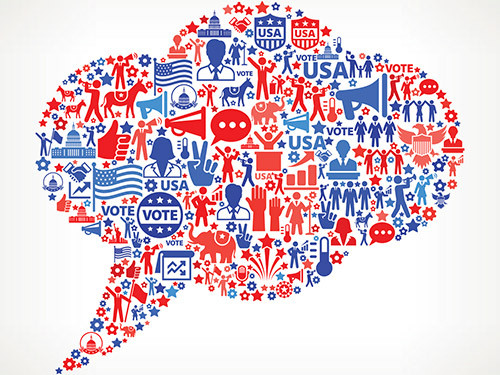 (Photo by iStock/Dmytro Varavin)
(Photo by iStock/Dmytro Varavin)
In the months leading up to any US presidential election, grassroots organizers of all types—community, labor, and electoral—usually undertake a predictable set of exercises. They register people to vote, familiarize voters with the candidates, and then turn people out to the polls. But the challenges of 2020 heightened the stakes of this year’s election to an existential level. Yes, Americans faced political struggle. But they also faced a fight to save lives, as the spread of COVID-19, wildfires tearing across the West, and the murders of unarmed Black Americans by police reminded us throughout the summer.
Organizers like those of us at Momentum, a movement-building nonprofit, knew that if President Trump didn’t win re-election, his campaign would likely contest election results even without evidence of fraud and resist the peaceful transfer of power as an act of disruption to the democratic process. Some of the potential scenarios organizers needed to brace for included: Governors and secretaries of state refusing to certify the popular vote in their state (which happened in 2000); the Supreme Court forcing states to stop counting the votes (also in 2000); or the government employing the police, the National Guard, and Customs and Border Patrol agents to crack down on Americans’ first amendment rights to protest (which of course happened earlier this year in response to uprisings prompted by George Floyd’s murder).

Even now that all major news outlets have called the presidential election for Joe Biden, organizers are preparing to grapple with the unprecedented. For example, state legislatures may choose a different slate of electors after the Electoral College’s Safe Harbor deadline in December, in an attempt to hand Trump a victory by overriding the popular vote. Or Trump may never concede that he’s lost. Either scenario could trigger a constitutional crisis, the likes of which the United States has never seen.
To most organizers, it’s felt absurd to plan for such unorthodox turns of events—and yet irresponsible not to. Biden’s campaign messaging was a reprisal of Warren Harding’s “Return to Normalcy” platform—a nostalgic message of restoration and repair he felt would appeal to beleaguered voters. But there’s no rosy yesteryear to return to, and past presidential elections provided little reassurance to organizers planning for this one. Organizers couldn’t afford to assume that the norms undergirding most other elections would hold this time around. Our team and other organizing groups around the country knew we had to work differently than any of us had before.
This manifested in coalitions such as Count On Us, Protect the Results, Frontline, and the Fight Back table, which went beyond get-out-the-vote efforts to plan for sustained mobilization in the wake of the election. All of these groups communicated a unified demand to #CountEveryVote, avoiding the pitfall of making the election about Democrats vs. Republicans instead of a sustained, noble fight for democracy. This time around, no one assumed that calling our representatives or attending a single march would be up to the task of ensuring that American democracy lived to see another day. But to understand the alternatives and what kind of mobilization would be most effective, many of us had to learn from movements abroad. And, in the process, we had to overcome assumptions that have guided electoral and community organizing in the United States for decades.
Reviving Civil Resistance
As our team began building a new approach, we turned to “civil resistance,” a growing field of practice and literature about the power of grassroots movements in undemocratic contexts. The premise of civil resistance is that ordinary people, not just politicians, have the means to enforce democratic outcomes. By refusing to comply or cooperate with unjust decisions (such as a decision to stop counting ballots in the wake of an election), citizens can deny undemocratic leaders the support they need from businesses, the media, civil servants, the police, and the military to carry out their orders.
Major civil resistance movements around the world have included the anti-apartheid movement in South Africa, the movement for Indian independence from British rule, the Palestinian struggle in the West Bank and Gaza, and the campaign that ended Slobodan Milosevic’s rule in Serbia. When Slobodan Milosevic refused to concede after he lost the 2000 Serbian election, for example, there were student protests, followed by a coal and copper miner strike, followed by state TV workers interrupting the regime’s regular programming, and finally by police abandoning their posts. These actions—combined with the work of political parties, trade unions, and civil society groups—forced Milosevic to step down.
Of course, civil resistance is far from unheard of in the United States. During the civil rights movement, Black organizers such as the Reverends James Lawson and Martin Luther King, Jr. began a rigorous translation of civil resistance in the American context, leading to protests like the Montgomery bus boycott in 1955, lunch counter sit-ins across the country in 1960, and the Birmingham Children’s March in 1963. Together, these campaigns moved institutions throughout society—including churches, schools, businesses, the media, government officials, and a broad swath of the American public—to support desegregation and the passage of the Voting Rights Act.
But while the Civil Rights Movement inspired a wave of other movements in the 1970s, such as the second-wave feminist movement and the anti-war movement, most of the grassroots organizations that survived that tumultuous period didn’t institutionalize the lessons of civil resistance. Consequently, the tradition was largely forgotten among American progressives. Even the US labor movement, which employed non-cooperation in the form of strikes to secure fair wages and safe working conditions for generations, diminished after the 1970s, with the rise of the Reagan alignment. As a result, civil resistance has been slow to rekindle among grassroots organizers. Instead, American organizing has operated on the assumption that our political institutions and processes will work. In 2020, it became clear that they might not—that they couldn’t guarantee either a democratic outcome or a peaceful transition of power.
Examining the successes and failures of international efforts reminded us that governors, secretaries of state, and legislators—the people organizers in the United States normally target to support initiatives like the Voting Rights Act or sign a pledge to count all votes—aren’t the only ones who can enforce democratic outcomes. This has been an essential insight for planning for the post-election moment: If protesting gets too cold or dangerous (say, prompting violence in the streets or the likely spread of COVID-19), ordinary people could create as much—likely more—political leverage by refusing to work or go to school. This is why unions like the Rochester AFL-CIO Labor Council have signaled the possibility of a general strike if President Trump doesn’t acknowledge the election’s outcome and why coalitions like Count On Us prepared “an army of young people” to escalate to a youth strike if needed.
So far, we haven’t had the need to effect something like a nationwide student strike or business boycott to enforce the election results this year. But if state legislatures attempt to override the popular vote or if the courts attempt to disqualify ballots without evidence, a growing number of progressive organizations are prepared for non-cooperation. And if we don’t need those tools before the inauguration on January 20, 2021, we’ll certainly need them in the decade to come.
Building People Power
Early on in the Trump presidency, many Democrats advocated for a “wait and see” approach, assuming that US political institutions were stronger than Trump himself. The opposite has proven true. US political institutions are weak, largely because they are undemocratic. Members of the Senate over-represent the white rural population, presidents can win the election without winning the popular vote, and the Supreme Court routinely rules against popular will. US political systems also rely on norms that commentators and legislators have wholly jettisoned in the 21st century.
It would be wrong to conclude that because Americans have voted President Trump out of office, US institutions were strong enough all along to withstand him. Those who argue for a return to normalcy—including Biden—will be disappointed to find that the US government continues to suffer from a crisis of legitimacy, which has contributed to the rise of rightwing populism and enduring support for Trump’s reactionary rhetoric. Indeed, 62 percent of Americans believe the fundamental structure of American government needs to change, but we have yet to translate that sentiment into law.
The good news is that the weakness of American political institutions has given birth to a range of powerful new movements in recent years. An increasingly energized civil society is taking action to deliver democracy where elected officials fail. People of all ages have been organizing in recent years, evidenced by the unprecedented scale of Occupy, the anti-Trump Resistance, and the Movement for Black Lives. In the past month alone, we’ve seen thousands of people take to the streets in celebration of democracy, businesses pledge to defend the integrity of the elections, and the mainstream media refuse to validate unfounded claims of voter fraud. More and more people and institutions across the country are activating a latent power they’ve always had to affirm and uphold a democratic common sense.
Still, just because popular movements in the United States are responses to political disintegration, it doesn’t mean they’re prepared to overcome it. Civil resistance teaches us that to overcome the most undemocratic aspects of government, organizers will have to generate mass noncompliance across sectors in ways we haven’t had to do for generations.
Whether we build that kind of people power in the coming years to make the United States a legitimate and truly representative democracy is a central question before us today. To bring about meaningful reform, civil society leaders will have to heed the most important lesson of civil resistance: that movements like those for women’s suffrage, the eight-hour workday, and desegregation succeeded only when they activated many thousands of people to stand up and stop cooperating for years at a time. Spurring thousands of people to rise up over and over again is an entirely different task than turning them into one-time voters or protesters. To achieve democracy reform—including historically redemptive legislation to get money out of politics, abolish the Electoral College, grant statehood to Washington, D.C. and Puerto Rico, ensure automatic voter registration, oversee fair redistricting in the states, and end centuries of voter suppression—millions of Americans will need to collectively refuse the disintegration of our political institutions.
A fraction of the roughly 161 million adults in the United States today who support a fundamental overhaul of our political system belong to any kind of grassroots organization. However, according to civil resistance scholar Erica Chenoweth, campaigns may only need 3.5 percent of any national population (about 12 million Americans) to engage in active, sustained participation to achieve sweeping reforms. To make good on the lessons of 2020, we need to plan for noncooperation at this scale. Organizers need to engineer systems for mass participation and for training thousands of new activists to take leadership roles. Social entrepreneurs and philanthropists need to invest in movements—those unique, multi-organizational fronts capable of reminding millions of people of their true power. And grassroots organizations, lobbyists, and policy makers need to alter long-standing metrics of success. In the coming decade, we must measure our success not by whether we’ve passed incremental reforms, but by whether we’ve built the organizational capacity and political will to create solutions commensurate with the problems of our political system.
Support SSIR’s coverage of cross-sector solutions to global challenges.
Help us further the reach of innovative ideas. Donate today.
Read more stories by Lissy Romanow.

